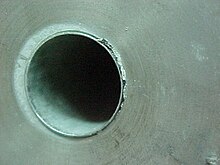SAE 316L grade stainless steel, sometimes referred to as A4 stainless steel or marine grade stainless steel, is the second most common austenitic stainless steel after 304/A2 stainless steel. Its primary alloying constituents after iron, are chromium (between 16–18%), nickel (10–12%) and molybdenum (2–3%), up to 2% manganese,[1] with small (<1%) quantities of silicon, phosphorus & sulfur also present. The addition of molybdenum provides greater corrosion resistance than 304, with respect to localized corrosive attack by chlorides and to general corrosion by reducing acids, such as sulfuric acid;[2] while sulfur is added to improve ease-of-tooling/machinability. 316L grade is the low carbon version of 316 stainless steel, which improves relative corrosion-resistance. When cold worked, 316 can produce high yield and tensile strengths similar to Duplex stainless grades.

It is commonly used in chemical and petrochemical industry, in food processing, pharmaceutical equipment, medical devices, jewellery, luxury watches (especially diver's watches), in potable water piping,[3][4] wastewater treatment,[5] in marine applications[6] and architectural applications near the seashore or in urban areas.[7][8]
Gallery
edit-
Pipe fitting of 316 steel (equivalent to A4 steel).
-
A fountain pen converter containing a 316 stainless ball of 2.5 mm diameter
-
Two welded 316L steel pipes.
-
Unpolished 316L steel.
-
Stress corrosion cracking in 316L by synthetic seawater
-
Hose barb pipe fitting in 316L
-
Citizen watch in 316L on a rubber strap
See also
editReferences
edit- ^ "Everything You Need to Know: 316L Stainless Steel". CPV Manufacturing. Retrieved 2024-07-22.
- ^ Kovach, Curtis W. (January 2002). "High Performance Stainless Steels". Nickel Institute. Retrieved 2018-12-22.
- ^ The Steel Construction Institute. "Resistance of stainless steel to corrosion in naturally occurring waters". Nickel Institute.
- ^ RE Avery, S. Lamb, C.A. Powell and A.H. Tuthill. "Stainless Steels for Potable Water Treatment Plants". Nickel Institute. Retrieved 2018-12-22.
{{cite web}}: CS1 maint: multiple names: authors list (link) - ^ A.H. Tuthill and S. Lamb. "Stainless Steel In Municipal WasteWater Treatment Plants". Nickel Institute.
- ^ "Guidelines for Nickel Stainless Steels for Marine Environments Natural Waters and Brines". Nickel Institute.
- ^ Houska, Catherine. "Stainless Steel in Architecture, Building and Construction". Nickel Institute.
- ^ American Iron and Steel Institute. "Design Guidelines for the Selection and Use of Stainless Steel". Nickel Institute.